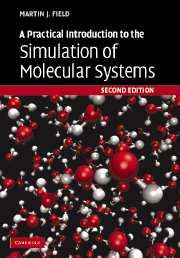Book contents
- Frontmatter
- Contents
- Preface to the first edition
- Preface to the second edition
- 1 Preliminaries
- 2 Chemical models and representations
- 3 Coordinates and coordinate manipulations
- 4 Quantum chemical models
- 5 Molecular mechanics
- 6 Hybrid potentials
- 7 Finding stationary points and reaction paths on potential energy surfaces
- 8 Normal mode analysis
- 9 Molecular dynamics simulations I
- 10 More on non-bonding interactions
- 11 Molecular dynamics simulations II
- 12 Monte Carlo simulations
- Appendix 1 The pDynamo library
- Appendix 2 Mathematical appendix
- Appendix 3 Solvent boxes and solvated molecules
- Bibliography
- Author index
- Subject index
7 - Finding stationary points and reaction paths on potential energy surfaces
Published online by Cambridge University Press: 03 December 2009
- Frontmatter
- Contents
- Preface to the first edition
- Preface to the second edition
- 1 Preliminaries
- 2 Chemical models and representations
- 3 Coordinates and coordinate manipulations
- 4 Quantum chemical models
- 5 Molecular mechanics
- 6 Hybrid potentials
- 7 Finding stationary points and reaction paths on potential energy surfaces
- 8 Normal mode analysis
- 9 Molecular dynamics simulations I
- 10 More on non-bonding interactions
- 11 Molecular dynamics simulations II
- 12 Monte Carlo simulations
- Appendix 1 The pDynamo library
- Appendix 2 Mathematical appendix
- Appendix 3 Solvent boxes and solvated molecules
- Bibliography
- Author index
- Subject index
Summary
Introduction
In the last three chapters we have discussed how to calculate the potential energy, and some of its derivatives, for a single geometry of the atoms in a system. Although the calculation of an energy for one or a small number of configurations may sometimes be necessary, it can give only limited information about a system's properties. To investigate the latter more thoroughly it is necessary to identify interesting or important regions on the system's potential energy surface and develop ways in which they can be explored. Methods to do this will be investigated in this chapter.
Exploring potential energy surfaces
The function that represents a system's potential energy surface is a multidimensional function of the positions of all the system's atoms. It is this surface that determines, in large part, the behaviour and the properties of the system. A little reflection shows that the number of configurations or geometries available to a system with more than a few atoms is enormous. A simple example should make this clear. Take a diatomic molecule or, more generally, any system comprising two atoms in vacuum. The geometry of such a molecule is completely determined by specifying the distance between the two atoms and so the potential energy surface is a function of only one geometrical variable. It is easy to search the entire potential energy surface for this system. Start with a small interatomic distance, calculate the energy, increase the distance by a certain amount and then repeat the procedure. In this way we can obtain a picture similar to those in Figures 5.1, 5.2 and 5.5.
Information
- Type
- Chapter
- Information
- A Practical Introduction to the Simulation of Molecular Systems , pp. 122 - 147Publisher: Cambridge University PressPrint publication year: 2007
